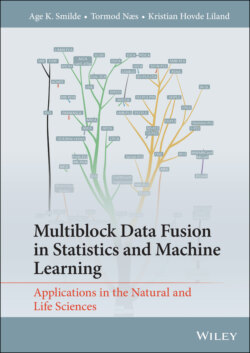Читать книгу Multiblock Data Fusion in Statistics and Machine Learning - Tormod Næs - Страница 31
ELABORATION 1.5 Terms in systems biology
ОглавлениеBiological networks:In biological organisms, biochemical compounds act together in networks of activity. An example is a metabolic network describing all the conversions taking place in the metabolism of a cell.Bottom-up:Approach in which detailed biochemical knowledge of a biological system is used to build mathematical models of that system (e.g., in terms of sets of differential equations). Such models are necessarily limited in size; they describe only a small part of the system.Emerging property:Property of a system which cannot be understood from its single actors. Temperature is an example of an emerging property of a system containing a large number of molecules that interact.Microbiome:The whole set of micro-organisms in and around a biological host. The gut-microbiome is the most famous example; essential for humans to metabolise food.Top-down:Approach in which many measurements are performed on the same biological system and empirical modelling is subsequently used to model that system. These models usually contain many biochemical compounds but are much less detailed than the bottom-up models.
An intriguing new development in systems biology is to involve microbiome measurements of the biological system (Franzosa et al., 2015). This has sparked many studies in different areas of medicine, such as inflammatory bowel disease (Huang et al., 2014) and cancer (Weir et al., 2013). It is also highly relevant for nutritional and food studies (Jacobs et al., 2009; Van Duynhoven et al., 2010; Moco et al., 2012). In all these cases, the microbiome data are combined with other omics data generating multiblock data analysis problems.
